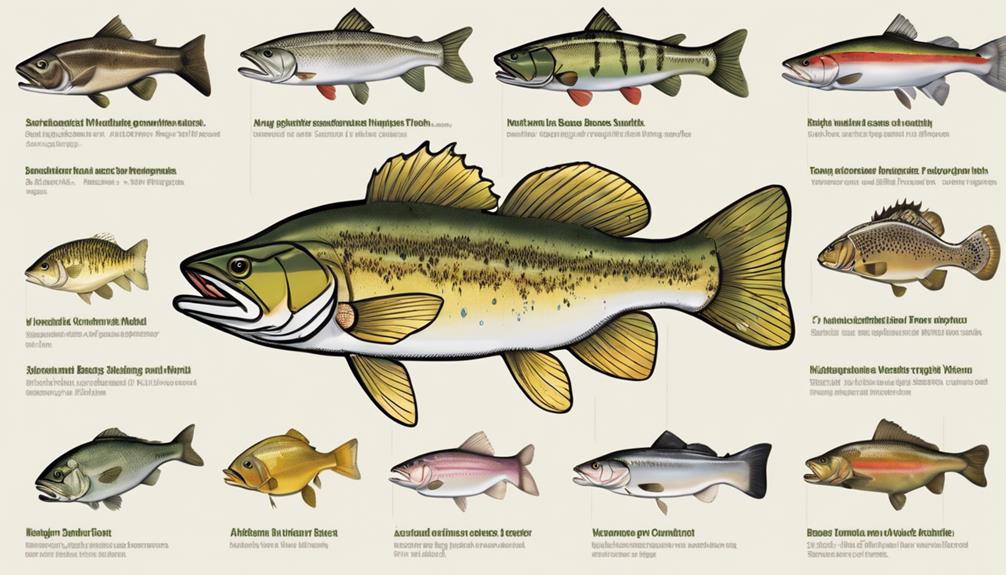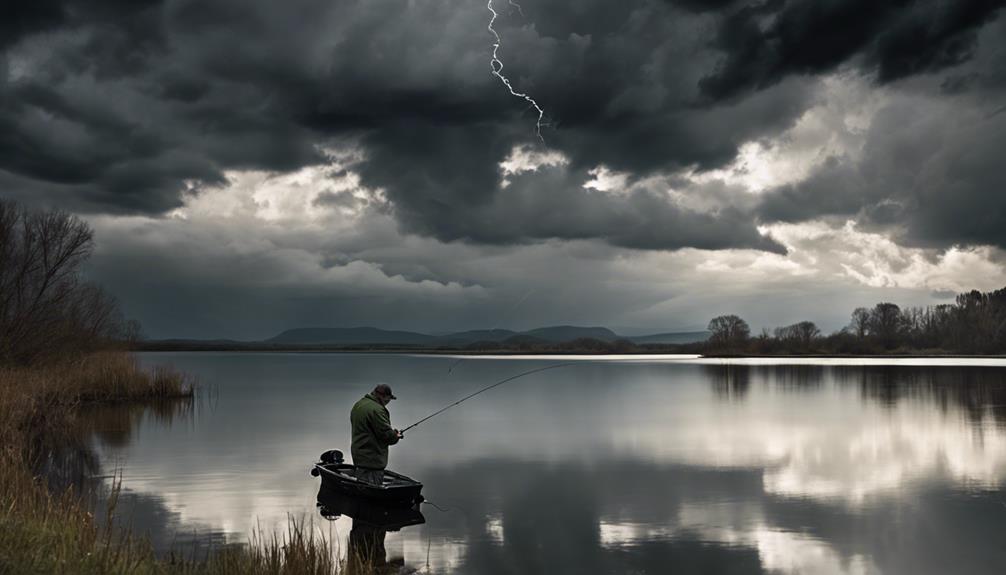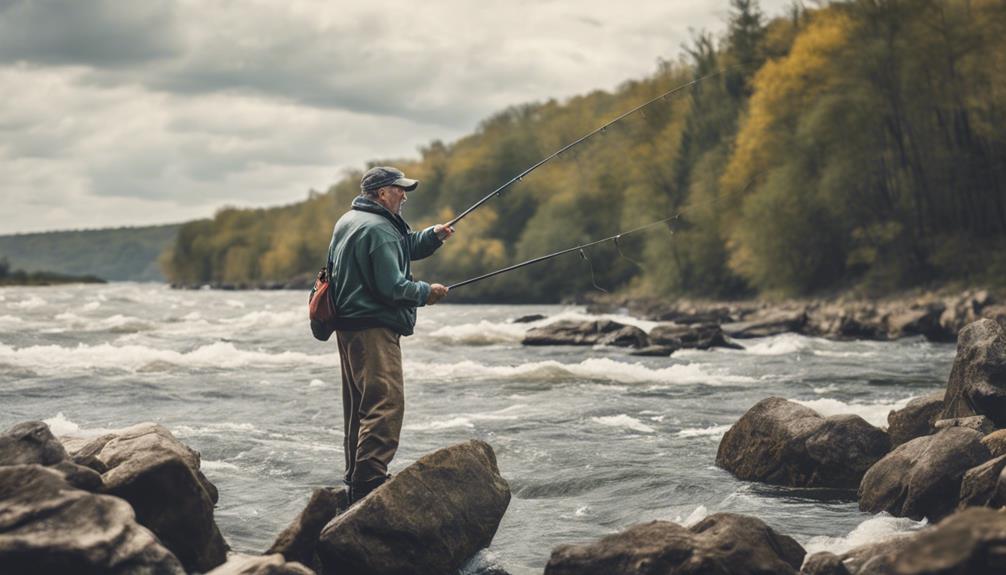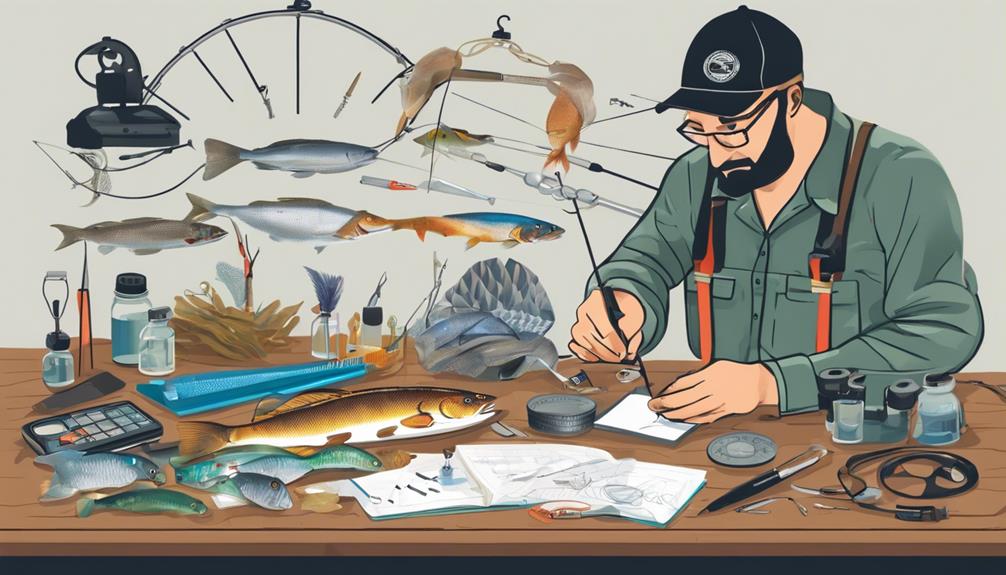When targeting trophy largemouth bass in a competitive angling event, mastering the art of flipping and pitching around heavy cover can give you an edge over your opponents. The precision required to drop your bait into tight spots where big bass lurk demands finesse and accuracy.
But what about when the serene waters hold the promise of a stunning trout but also pose a challenge? Understanding the nuances of trout behavior and adapting your techniques accordingly could be the key to clinching the top spot in the next tournament.
Bass Fishing Techniques
Mastering the art of casting accurately is crucial for successful bass fishing. When it comes to bass fishing techniques, two key elements to focus on are lure selection and casting techniques. Choosing the right lure can make all the difference. Bass can be picky, so having a variety of lures in your tackle box is essential. Different types of lures work better depending on the conditions and the behavior of the bass on that particular day. Experiment with various sizes, colors, and movements to see what the bass are responding to.
In addition to lure selection, honing your casting techniques is vital. Practice different casting methods such as flipping, pitching, and casting parallel to the shore. Understanding how to accurately place your lure near structures where bass might be hiding is crucial.
Weather conditions play a significant role in bass fishing. Bass are sensitive to changes in weather, so keeping an eye on the forecast can give you an advantage. On cloudy days, bass tend to be more active near the surface, while on sunny days, they might seek shelter in deeper waters. Adjust your lure selection and casting techniques accordingly to adapt to the weather conditions.
Lastly, scouting the right location is key. Look for areas with underwater structures like rocks, fallen trees, or vegetation where bass are likely to gather. By combining proper lure selection, casting techniques, consideration of weather conditions, and effective location scouting, you can increase your chances of a successful bass fishing outing.
Trout Competition Tips
To excel in trout competitions, sharpen your skills in identifying prime fishing spots with a focus on precision casting techniques. When it comes to trout fishing tournaments, honing your fly fishing skills and mastering stream navigation techniques are essential. Here are some key tips to help you up your game:
- Study the Water: Understanding the behavior of trout and their preferred habitats is crucial. Look for areas with good cover, such as rocks, logs, or overhanging vegetation, where trout are likely to hide.
- Perfect Your Cast: Practice precision casting to target specific spots where trout are lurking. Work on your accuracy to avoid spooking the fish and increase your chances of a successful catch.
- Use the Right Flies: Match the hatch by selecting flies that mimic the insects present in the area. Pay attention to the size, color, and movement of the flies to attract the interest of discerning trout.
- Stay Stealthy: Trout have keen eyesight and are easily startled. Approach the fishing spot with caution, avoid making sudden movements, and use light line to increase your chances of a bite.
- Adapt to Conditions: Be adaptable and willing to switch up your techniques based on the weather, water conditions, and the behavior of the trout. Stay observant and be prepared to make quick adjustments to maximize your success in the competition.
Catfish Tournament Strategies
To elevate your performance in catfish tournaments, implement specialized angling techniques tailored to this species. Catfish are often attracted to strong-smelling baits like chicken liver, stink bait, or live bait such as shad or bluegill. When it comes to catfish baiting techniques, consider using punch baits that can be easily secured onto treble hooks. Additionally, having the right equipment is crucial. Opt for a sturdy rod and reel combo with a heavy test line, as catfish are known for their strength and ability to put up a fight.
Night fishing can be particularly productive when targeting catfish. These fish are more active during low light conditions and tend to feed more aggressively at night. Utilize night fishing strategies by using glow-in-the-dark floats or electronic bite alarms to detect subtle bites in the dark. Location scouting is also key in catfish tournaments. Look for areas with structure like fallen trees, rocks, or deep holes where catfish are likely to hide during the day.
Walleye Fishing Tactics
When targeting Walleye, selecting the right bait and fishing depth is crucial for increasing your chances of a successful catch. Walleye are known for their elusive nature, so honing in on the correct techniques can make all the difference in your angling success.
Here are some tips to enhance your Walleye fishing tactics:
- Experiment with Jigging Techniques: Walleye are often attracted to subtle movements, so mastering various jigging styles can help entice them to bite.
- Utilize Trolling Tips: Trolling can be an effective way to cover a larger area of water and locate schools of Walleye. Adjust your trolling speed and depth to find the optimal presentation.
- Consider Live Bait: Minnows, leeches, and nightcrawlers are popular live bait choices for Walleye. Make sure to present the bait naturally to increase your chances of a bite.
- Try Artificial Lures: Crankbaits, jigs, and spinners can also be successful in attracting Walleye. Experiment with different colors and sizes to see what the Walleye in your area prefer.
- Pay Attention to Depth: Walleye tend to inhabit specific depths depending on factors like time of day and water temperature. Use a fish finder to locate the right depth where Walleye are likely to be feeding.
Pike Angling Approaches
Mastering effective angling approaches for Pike involves understanding their predatory behavior and preferred habitats. When targeting Pike, lure selection is crucial. Opt for large, flashy lures that mimic the fish they prey on, such as smaller fish or even ducklings. These predatory instincts trigger their hunting response. Employing casting techniques that allow you to cover a wide area is key. Make long casts towards structures like weed beds, fallen trees, or rocky outcrops where Pike often lurk.
Depth control is another essential aspect. Pike are known to occupy varying depths depending on the time of day and weather conditions. Use depth finders to locate these fish at different levels of the water column. Adjust your bait's depth accordingly to increase your chances of a successful catch.
Boat positioning can greatly impact your Pike angling success. To effectively target Pike, position your boat to cover prime habitats. Drift or troll along drop-offs, underwater ledges, or near vegetation where Pike tend to congregate. By strategically maneuvering your boat, you can present your lure in the most enticing manner to trigger a strike.
Salmon Championship Methods
Employ tried and tested strategies to enhance your success in competitive salmon angling championships. When it comes to salmon championship methods, having the right approach can make all the difference. Here are some key tactics to keep in mind:
- Fly Fishing Tactics: In salmon angling championships, mastering fly fishing tactics is crucial. Focus on presenting your fly in a natural and enticing manner to attract salmon effectively.
- Fly Selection: Choosing the right fly is essential. Opt for patterns that mimic the insects or baitfish present in the water to increase your chances of a successful catch.
- Rod and Reel Choices: Selecting the appropriate rod and reel can significantly impact your performance. Ensure you have equipment that matches the size and strength of the salmon you're targeting.
- Casting Techniques: Perfecting your casting techniques is vital for reaching distant or challenging spots where salmon may be hiding. Practice precision casting to improve your accuracy.
- Stay Persistent: Salmon can be elusive, so persistence is key. Keep trying different techniques, adjusting your approach as needed, and remain patient until you find what works best in the competition waters.
Carp Tournament Tricks
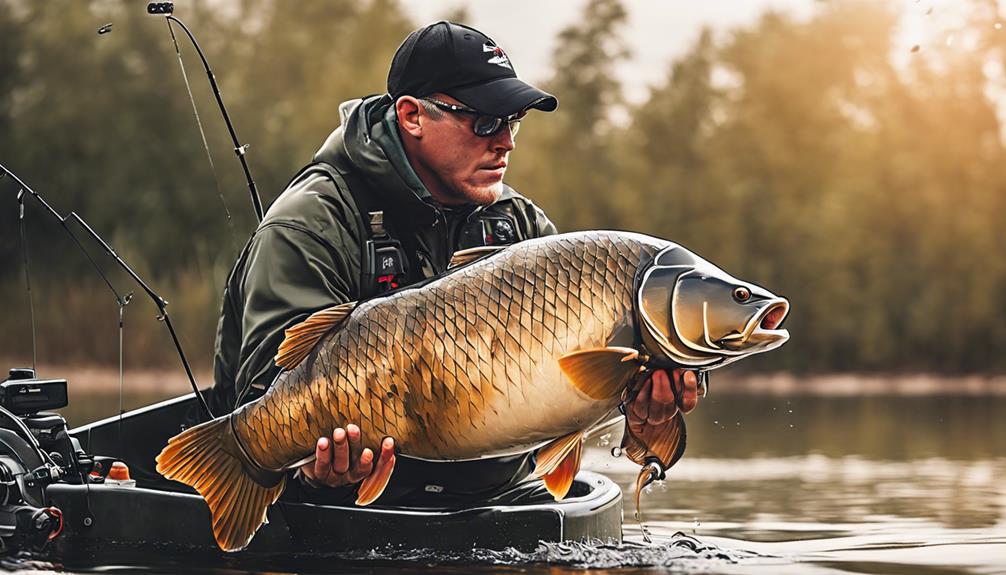
Enhance your competitive edge in carp tournaments with savvy tricks and tactics that can boost your chances of success. When it comes to carp baiting tactics, consider using a mix of sweet and savory baits to appeal to the diverse palate of carp. Experiment with maize, boilies, and flavored pellets to see what works best in the waters you're fishing. A stealthy approach is key when targeting carp, as these fish are known for their wariness. Avoid making loud noises or sudden movements that could spook the carp away.
Rod selection plays a crucial role in carp fishing tournaments. Opt for a strong, yet flexible rod that can handle the weight and power of carp. A good carp rod will allow you to control the fish during the fight and increase your chances of landing it successfully. When it comes to casting, practice precise techniques to accurately place your bait where the carp are feeding. Work on your casting accuracy to ensure that your bait lands right in front of the carp without causing any disturbances.
Bluegill Competition Secrets
Discover effective strategies to dominate bluegill competitions with insider tips and techniques that will give you a competitive edge. When it comes to bluegill competition secrets, success lies in the details. To increase your chances of catching big bluegill and outperforming your competitors, consider the following tips:
- Bluegill bait selection: Opt for live bait such as worms, crickets, or grasshoppers to attract bluegill effectively. Artificial baits like small jigs or flies can also be successful if presented correctly.
- Master the art of presentation: Bluegill can be picky eaters, so pay attention to how you present your bait. Use light tackle and finesse techniques to mimic natural movements and entice more bites.
- Explore different depths: Bluegill can often be found at varying depths depending on the time of day and water temperature. Experiment with different depths until you find where the bigger bluegill are hiding.
- Stay patient and observant: Bluegill can be cautious and easily spooked. Be patient, observe their behavior, and adjust your tactics accordingly to maximize your chances of a successful catch.
- Fish during optimal times: Bluegill are most active during dawn and dusk. Plan your fishing trips during these times to increase your chances of encountering more bluegill and potentially catching bigger fish.
Frequently Asked Questions
What Are Some Common Mistakes Anglers Make When Competing in Fishing Tournaments?
When competing in fishing tournaments, common pitfalls include lack of preparation and underestimating the mental game. To avoid these mistakes, focus on honing your skills and developing winning strategies.
Be mentally prepared for the challenges ahead and ensure you have the right gear and knowledge. By staying focused and proactive, you can improve your chances of success in competitive angling.
How Important Is It to Understand the Behavior and Habitat of Different Fish Species in Competitive Angling?
Understanding fish behavior and habitat is crucial for your angling success in competitive tournaments. Your knowledge of different fish species' tendencies and preferred environments gives you a competitive advantage.
Are There Any Specific Regulations or Rules to Be Aware of When Participating in Fishing Tournaments?
When you're entering fishing tournaments, it's crucial to know the tournament regulations inside and out. Understanding the rules ensures fair play and upholds ethics in the competition.
How Do Weather Conditions Affect the Success of Competitive Angling?
Weather conditions play a crucial role in the success of competitive angling. The impact of barometric pressure and wind direction can greatly affect fish behavior and feeding patterns. Understanding how these factors influence the water can help you adjust your strategies accordingly.
Keep an eye on changing weather forecasts and adapt your approach to maximize your chances of a successful fishing tournament.
Are There Any Specialized Techniques or Equipment That Are Particularly Effective in Competitive Angling for Various Fish Species?
When angling competitively for various fish species, specialized techniques and effective equipment play a crucial role in increasing your success. By honing specific skills and using the right gear tailored to each species, you can greatly improve your chances of landing the biggest catches.
Whether it's mastering a particular casting technique or selecting the ideal bait, focusing on these aspects can give you a competitive edge in the world of angling.
Conclusion
Now that you have learned winning strategies for competitive angling across various fish species, it's time to put your skills to the test on the water.
Remember to stay focused, adapt to changing conditions, and always be prepared with the right gear.
With practice and patience, you can increase your chances of success in tournaments and competitions.
Good luck out there and happy fishing!
